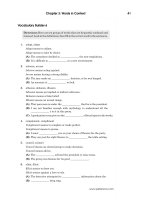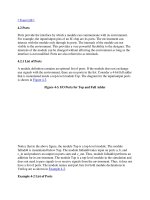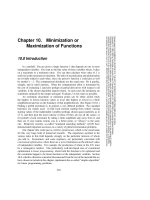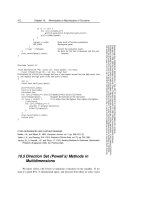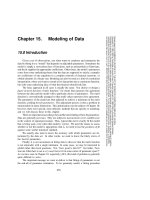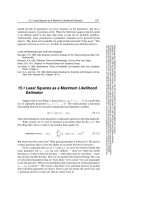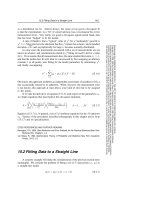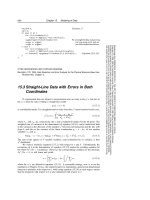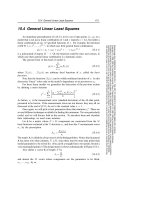Tài liệu Evaluation of Functions part 6 pptx
Bạn đang xem bản rút gọn của tài liệu. Xem và tải ngay bản đầy đủ của tài liệu tại đây (97.17 KB, 6 trang )
178
Chapter 5. Evaluation of Functions
Sample page from NUMERICAL RECIPES IN C: THE ART OF SCIENTIFIC COMPUTING (ISBN 0-521-43108-5)
Copyright (C) 1988-1992 by Cambridge University Press.Programs Copyright (C) 1988-1992 by Numerical Recipes Software.
Permission is granted for internet users to make one paper copy for their own personal use. Further reproduction, or any copying of machine-
readable files (including this one) to any servercomputer, is strictly prohibited. To order Numerical Recipes books,diskettes, or CDROMs
visit website or call 1-800-872-7423 (North America only),or send email to (outside North America).
Then the answer is
√
c + id =
0 w =0
w+i
d
2w
w=0,c≥0
|d|
2w
+iw w =0,c<0,d≥0
|d|
2w
−iw w =0,c<0,d<0
(5.4.7)
Routines implementing these algorithms are listed in Appendix C.
CITED REFERENCES AND FURTHER READING:
Midy, P., and Yakovlev, Y. 1991,
Mathematics and Computers in Simulation
, vol. 33, pp. 33–49.
Knuth, D.E. 1981,
Seminumerical Algorithms
, 2nd ed., vol. 2 of
The Art of Computer Programming
(Reading, MA: Addison-Wesley) [see solutions to exercises 4.2.1.16 and 4.6.4.41].
5.5 Recurrence Relations and Clenshaw’s
Recurrence Formula
Many useful functions satisfy recurrence relations, e.g.,
(n +1)P
n+1
(x)=(2n+1)xP
n
(x)− nP
n−1
(x) (5.5.1)
J
n+1
(x)=
2n
x
J
n
(x)−J
n−1
(x) (5.5.2)
nE
n+1
(x)=e
−x
−xE
n
(x) (5.5.3)
cos nθ =2cosθcos(n − 1)θ − cos(n − 2)θ (5.5.4)
sin nθ =2cosθsin(n − 1)θ − sin(n − 2)θ (5.5.5)
where the first threefunctions are Legendre polynomials,Bessel functionsof the first
kind, and exponential integrals, respectively. (For notation see
[1]
.) These relations
are useful for extending computational methods from two successive values of n to
other values, either larger or smaller.
Equations (5.5.4) and (5.5.5) motivateus to say a few words about trigonometric
functions. If your program’s running time is dominated by evaluating trigonometric
functions,you areprobablydoingsomething wrong. Trig functionswhose arguments
form a linear sequence θ = θ
0
+ nδ, n =0,1,2,..., are efficiently calculated by
the following recurrence,
cos(θ + δ)=cosθ−[αcos θ + β sin θ]
sin(θ + δ)=sinθ−[αsin θ − β cos θ]
(5.5.6)
5.5 Recurrence Relations and Clenshaw’s Recurrence Formula
179
Sample page from NUMERICAL RECIPES IN C: THE ART OF SCIENTIFIC COMPUTING (ISBN 0-521-43108-5)
Copyright (C) 1988-1992 by Cambridge University Press.Programs Copyright (C) 1988-1992 by Numerical Recipes Software.
Permission is granted for internet users to make one paper copy for their own personal use. Further reproduction, or any copying of machine-
readable files (including this one) to any servercomputer, is strictly prohibited. To order Numerical Recipes books,diskettes, or CDROMs
visit website or call 1-800-872-7423 (North America only),or send email to (outside North America).
where α and β are the precomputed coefficients
α ≡ 2sin
2
δ
2
β≡sin δ (5.5.7)
The reason for doing things this way, rather than with the standard (and equivalent)
identities for sums of angles, is that here α and β do not lose significance if the
incremental δ is small. Likewise, the adds in equation (5.5.6) should be done in
the order indicated by square brackets. We will use (5.5.6) repeatedly in Chapter
12, when we deal with Fourier transforms.
Another trick, occasionally useful, is to note that both sin θ and cos θ can be
calculated via a single call to tan:
t ≡ tan
θ
2
cos θ =
1 − t
2
1+t
2
sin θ =
2t
1+t
2
(5.5.8)
The cost of getting both sin and cos, if you need them, is thus the cost of tan plus
2 multiplies, 2 divides, and 2 adds. On machines with slow trig functions, this can
be a savings. However, note that special treatment is required if θ →±π.Andalso
note that many modern machines have very fast trig functions; so you should not
assume that equation (5.5.8) is faster without testing.
Stability of Recurrences
You need to be aware that recurrence relations are not necessarily stable
against roundoff error in the direction that you propose to go (either increasing n or
decreasing n). A three-term linear recurrence relation
y
n+1
+ a
n
y
n
+ b
n
y
n−1
=0,n=1,2,... (5.5.9)
has two linearly independent solutions, f
n
and g
n
say. Only one of these corresponds
to the sequence of functions f
n
that you are trying to generate. The other one g
n
may be exponentially growing in the direction that you want to go, or exponentially
damped, or exponentiallyneutral (growingordyingas somepowerlaw, for example).
If it is exponentially growing, then the recurrence relation is of little or no practical
use in that direction. This is the case, e.g., for (5.5.2) in the direction of increasing
n,whenx<n. You cannot generate Bessel functions of high n by forward
recurrence on (5.5.2).
To state things a bit more formally, if
f
n
/g
n
→ 0 as n →∞ (5.5.10)
then f
n
is called the minimal solution of the recurrence relation (5.5.9). Nonminimal
solutions like g
n
are called dominant solutions. The minimal solution is unique, if it
exists, but dominant solutions are not — you can add an arbitrary multiple of f
n
to
agiveng
n
. You can evaluate any dominant solution by forward recurrence, but not
the minimal solution. (Unfortunately it is sometimes the one you want.)
Abramowitz and Stegun (in their Introduction)
[1]
give a list of recurrences that
are stable in the increasing or decreasing directions. That list does not contain all
180
Chapter 5. Evaluation of Functions
Sample page from NUMERICAL RECIPES IN C: THE ART OF SCIENTIFIC COMPUTING (ISBN 0-521-43108-5)
Copyright (C) 1988-1992 by Cambridge University Press.Programs Copyright (C) 1988-1992 by Numerical Recipes Software.
Permission is granted for internet users to make one paper copy for their own personal use. Further reproduction, or any copying of machine-
readable files (including this one) to any servercomputer, is strictly prohibited. To order Numerical Recipes books,diskettes, or CDROMs
visit website or call 1-800-872-7423 (North America only),or send email to (outside North America).
possible formulas, of course. Given a recurrence relation for some function f
n
(x)
you can test it yourself with about five minutes of (human) labor: For a fixed x
in your range of interest, start the recurrence not with true values of f
j
(x) and
f
j+1
(x), but (first) with the values 1 and 0, respectively, and then (second) with
0 and 1, respectively. Generate 10 or 20 terms of the recursive sequences in the
direction that you want to go (increasing or decreasing from j), for each of the two
starting conditions. Look at the difference between the corresponding members of
the two sequences. If the differences stay of order unity (absolute value less than
10, say), then the recurrence is stable. If they increase slowly, then the recurrence
may be mildly unstable but quite tolerably so. If they increase catastrophically,
then there is an exponentially growing solution of the recurrence. If you know
that the function that you want actually corresponds to the growing solution, then
you can keep the recurrence formula anyway e.g., the case of the Bessel function
Y
n
(x) for increasing n,see§6.5; if you don’t know which solution your function
corresponds to, you must at this point reject the recurrence formula. Notice that
you can do this test before you go to the trouble of finding a numerical method for
computing the two starting functions f
j
(x) and f
j+1
(x): stability is a property of
the recurrence, not of the starting values.
An alternative heuristic procedure for testing stability is to replace the recur-
rence relation by a similar one that is linear with constant coefficients. For example,
the relation (5.5.2) becomes
y
n+1
− 2γy
n
+ y
n−1
=0 (5.5.11)
where γ ≡ n/x is treated as a constant. You solve such recurrence relations
by trying solutions of the form y
n
= a
n
. Substituting into the above recur-
rence gives
a
2
− 2γa +1=0 or a = γ ±
γ
2
− 1(5.5.12)
The recurrence is stable if |a|≤1for all solutions a. This holds (as you can verify)
if |γ|≤1or n ≤ x. The recurrence (5.5.2) thus cannot be used, starting with J
0
(x)
and J
1
(x), to compute J
n
(x) for large n.
Possibly you would at this point like the security of some real theorems on
this subject (although we ourselves always follow one of the heuristic procedures).
Here are two theorems, due to Perron
[2]
:
Theorem A. If in (5.5.9) a
n
∼ an
α
, b
n
∼ bn
β
as n →∞,andβ<2α,then
g
n+1
/g
n
∼−an
α
,f
n+1
/f
n
∼−(b/a)n
β−α
(5.5.13)
and f
n
is the minimal solution to (5.5.9).
Theorem B. Under the same conditions as Theorem A, but with β =2α,
consider the characteristic polynomial
t
2
+ at + b =0 (5.5.14)
If the roots t
1
and t
2
of (5.5.14) have distinct moduli, |t
1
| > |t
2
| say, then
g
n+1
/g
n
∼ t
1
n
α
,f
n+1
/f
n
∼ t
2
n
α
(5.5.15)
5.5 Recurrence Relations and Clenshaw’s Recurrence Formula
181
Sample page from NUMERICAL RECIPES IN C: THE ART OF SCIENTIFIC COMPUTING (ISBN 0-521-43108-5)
Copyright (C) 1988-1992 by Cambridge University Press.Programs Copyright (C) 1988-1992 by Numerical Recipes Software.
Permission is granted for internet users to make one paper copy for their own personal use. Further reproduction, or any copying of machine-
readable files (including this one) to any servercomputer, is strictly prohibited. To order Numerical Recipes books,diskettes, or CDROMs
visit website or call 1-800-872-7423 (North America only),or send email to (outside North America).
and f
n
is again the minimal solution to (5.5.9). Cases other than those in these
two theorems are inconclusive for the existence of minimal solutions. (For more
on the stability of recurrences, see
[3]
.)
How do you proceed if the solution that you desire is the minimal solution?
The answer lies in that old aphorism, that every cloud has a silver lining: If a
recurrence relation is catastrophically unstable in one direction, then that (undesired)
solution will decrease very rapidly in the reverse direction. This means that you
can start with any seed values for the consecutive f
j
and f
j+1
and (when you have
gone enough steps in the stable direction) you will converge to the sequence of
functions that you want, times an unknown normalization factor. If there is some
other way to normalize the sequence (e.g., by a formula for the sum of the f
n
’s),
then this can be a practical means of function evaluation. The method is called
Miller’s algorithm. An example often given
[1,4]
uses equation (5.5.2) in just this
way, along with the normalization formula
1=J
0
(x)+2J
2
(x)+2J
4
(x)+2J
6
(x)+··· (5.5.16)
Incidentally, there is an important relation between three-term recurrence
relations and continued fractions. Rewrite the recurrence relation (5.5.9) as
y
n
y
n−1
= −
b
n
a
n
+ y
n+1
/y
n
(5.5.17)
Iterating this equation, starting with n,gives
y
n
y
n−1
=−
b
n
a
n
−
b
n+1
a
n+1
−
··· (5.5.18)
Pincherle’s Theorem
[2]
tells us that (5.5.18) converges if and only if (5.5.9) has a
minimal solution f
n
, in which case it converges to f
n
/f
n−1
. This result, usually for
the case n =1andcombinedwithsomewaytodeterminef
0
, underlies many of the
practical methods for computing special functions that we give in the next chapter.
Clenshaw’s Recurrence Formula
Clenshaw’s recurrence formula
[5]
is an elegant and efficient way to evaluate a
sum of coefficients times functions that obey a recurrence formula, e.g.,
f(θ)=
N
k=0
c
k
cos kθ or f(x)=
N
k=0
c
k
P
k
(x)
Here is how it works: Suppose that the desired sum is
f(x)=
N
k=0
c
k
F
k
(x)(5.5.19)
and that F
k
obeys the recurrence relation
F
n+1
(x)=α(n, x)F
n
(x)+β(n, x)F
n−1
(x)(5.5.20)
182
Chapter 5. Evaluation of Functions
Sample page from NUMERICAL RECIPES IN C: THE ART OF SCIENTIFIC COMPUTING (ISBN 0-521-43108-5)
Copyright (C) 1988-1992 by Cambridge University Press.Programs Copyright (C) 1988-1992 by Numerical Recipes Software.
Permission is granted for internet users to make one paper copy for their own personal use. Further reproduction, or any copying of machine-
readable files (including this one) to any servercomputer, is strictly prohibited. To order Numerical Recipes books,diskettes, or CDROMs
visit website or call 1-800-872-7423 (North America only),or send email to (outside North America).
for some functions α(n, x) and β(n, x). Now define the quantities y
k
(k =
N, N − 1,...,1) by the following recurrence:
y
N+2
= y
N +1
=0
y
k
=α(k, x)y
k+1
+ β(k +1,x)y
k+2
+ c
k
(k = N, N − 1,...,1)
(5.5.21)
If you solve equation (5.5.21) for c
k
on the left, and then write out explicitly the
sum (5.5.19), it will look (in part) like this:
f(x)=···
+[y
8
−α(8,x)y
9
−β(9,x)y
10
]F
8
(x)
+[y
7
−α(7,x)y
8
−β(8,x)y
9
]F
7
(x)
+[y
6
−α(6,x)y
7
−β(7,x)y
8
]F
6
(x)
+[y
5
−α(5,x)y
6
−β(6,x)y
7
]F
5
(x)
+···
+[y
2
−α(2,x)y
3
−β(3,x)y
4
]F
2
(x)
+[y
1
−α(1,x)y
2
−β(2,x)y
3
]F
1
(x)
+[c
0
+β(1,x)y
2
−β(1,x)y
2
]F
0
(x)
(5.5.22)
Notice that we have added and subtracted β(1,x)y
2
in the last line. If you examine
the terms containing a factor of y
8
in (5.5.22), you will find that they sum to zero as
a consequence of the recurrence relation (5.5.20); similarly all the other y
k
’s down
through y
2
. The only surviving terms in (5.5.22) are
f(x)=β(1,x)F
0
(x)y
2
+F
1
(x)y
1
+F
0
(x)c
0
(5.5.23)
Equations (5.5.21) and (5.5.23) are Clenshaw’srecurrence formula for doing the sum
(5.5.19): You make one pass down through the y
k
’s using (5.5.21); when you have
reached y
2
and y
1
you apply (5.5.23) to get the desired answer.
Clenshaw’s recurrence as written above incorporates the coefficients c
k
in a
downward order, with k decreasing. At each stage, the effect of all previous c
k
’s
is “remembered” as two coefficients which multiply the functions F
k+1
and F
k
(ultimately F
0
and F
1
). If the functions F
k
are small when k is large, and if the
coefficients c
k
are small when k is small, then the sum can be dominated by small
F
k
’s. In this case the remembered coefficients will involve a delicate cancellation
and there can be a catastrophic loss of significance. An example would be to sum
the trivial series
J
15
(1) = 0 × J
0
(1) + 0 × J
1
(1) + ...+0×J
14
(1) + 1× J
15
(1) (5.5.24)
Here J
15
, which is tiny, ends up represented as a canceling linear combination of
J
0
and J
1
, which are of order unity.
